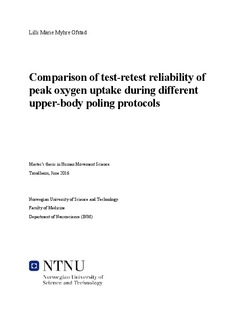| dc.description.abstract | Background and purpose: Upper body poling is a sport-specific exercise mode for several Paralympic sports such as Nordic sit ski and ice sledge hockey. However, there is a lack of reliable and standardized tests to evaluate changes in physical fitness, such as peak oxygen uptake (VO2peak), in this mode. The primary purpose of this study was therefore to examine the test-retest reliability of VO2peak and the corresponding physiological variables in three different test-protocols in upper body poling. The secondary purpose was to investigate which protocol resulted in the highest VO2peak. Methods: 23 healthy upper-body trained men participated in the study, which involved two days of testing (3.9±3.3 days apart). Body composition was assessed with an InBody scale. On both test days, subjects performed the three different test protocols to exhaustion; a 1-min and a 3-min self-paced all-out test as well as an incremental test to failure. The test order was randomized across subjects, but the same order was applied both days. The subjects were placed in front of a poling ergometer in a seated position and with feet locked. Variables included in the study were VO2peak, peak heart rate (HRpeak), peak blood lactate concentration (BLapeak), muscular-, respiratory- and over-all rating of perceived exertion (RPE) and power output. Statistical significance was set as p≤ 0.05. Reliability was determined by intraclass correlation coefficient (ICC) and coefficient of variation (CV). Limits of agreement (LOA) were also investigated. Results: A high ICC (0.938-0.950) and low CV (0.4-1.2 %) between test and retest show a high reliability in VO2peak withtin all three test protocols. There were no significant differences in VO2peak, RERpeak, HRpeak, respiratory RPE, over-all RPE or BLapeak between test and retest in the 1-min test, 3-min test or the incremental test (all p<0.005). A significantly higher power output in the retest for all three protocols were found (p<0.05), as well as a significantly higher VEpeak in the retest for the incremental protocol (p<0.05) and a lower muscular RPE in the retest for the 1-min protocol (p<0.05). Subjects reached 5.5 % (p <0.05) and 7.9 %(p< 0.05) higher VO2peak in the 3- min protocol and the incremental test compared to the 1-min test, respectively. The incremental protocol resulted in a 4.6 % higher VO2peak than the 3-min test (p< 0.05) Conclusion: The 1-min protocol, 3-min protocol and the incremental test do all have a high reliability when it comes to VO2peak, RERpeak, HRpeak, respiratory RPE, over-all RPE and BLapeak. A significant difference in power output might be due to a systematic error in terms of a learning effect. However, all three test protocols were found reliable for testing of VO2peak in upper-body poling. The highest VO2peak were obtained with the incremental protocol, and should be the recommended test for detection of VO2peak in upper-body poling. | nb_NO |
